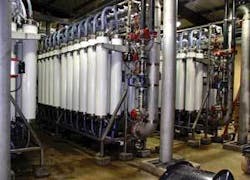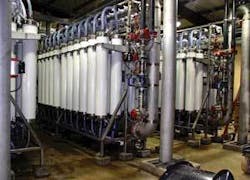Texas Utilities Turning to UF Membrane Treatment
For more than two centuries, the Edwards Aquifer, one of the most prolific artesian aquifers in the world, has enabled San Antonio, TX, and many other cities and towns in the surrounding region to grow and prosper without using surface water.
Historically, the Edwards Aquifer was able to serve the diverse agricultural, industrial, recreational and domestic water needs of almost two million users in south central Texas, allowing San Antonio to emerge as America’s eighth largest city, despite the semi-arid climate at the edge of the vast Chihuahuan Desert.
During recent decades, however, demand for water in the region has increased well beyond the aquifer’s capacity, leading to increasing concerns about the welfare of endangered species and regional economies that depend on spring flows from the aquifer.
Strict limits have been placed on the use of the aquifer, forcing water districts to rapidly develop surface water resources to satisfy existing potable water needs and to support future growth. The challenge has been to increase capacity while meeting the stringent regulatory requirements of the Safe Drinking Water Act (SDWA).
To meet the capacity requirements and safe water regulations, several water districts have turned to ultrafiltration (UF) membrane technology. One of the first to do so was Canyon Regional Water Authority (CRWA) at its plants in New Braunfels and San Marcos, northeast of San Antonio.
“When we were faced with the need for rapid expansion of our surface water treatment capacity, we decided to utilize membrane filtration because it could filter far more water at a lower cost and in a smaller footprint than the conventional sand filtration system we had in operation,” said David J. Davenport, the general manager of CRWA.
In June 2002, the New Braunfels plant commissioned a 4 mgd ultrafiltration system composed of two parallel units each containing 48, 8-inch diameter by 72-inch long PMPWTM hollow fiber cartridges from Koch Membrane Systems. A single, 2 mgd unit was also installed at a newly constructed CRWA plant in San Marcos.
“Within a month of commissioning our new membrane system, it was immediately put to the test by a 500-year flood and exceptionally high turbidity levels,” Davenport said. “It was amazing to see the membrane system continue to perform, while the conventional sand filtration systems in the local area needed to be shut down.”
The turbidity levels rose to record highs - reaching 4,000 NTU on July 5, 2002. The membrane system continued operating throughout the crisis, providing water to the two above-ground clearwells and continuing to distribute high quality water to CRWA’s customers.
“This experience demonstrated the most beneficial aspect of membrane technology: its ability to supply quality drinking water regardless of the turbidity levels in the feed water,” Davenport said.
During a normal July and August, when demand for water is at its highest, the turbidity of the feed water from the Guadalupe River typically fluctuates between 6 NTU and more than 100 NTU, averaging approximately 17 NTU. The PMPW polysulfone membranes have a pore size that provides a 100,000 molecular weight cutoff. This mechanical barrier produces consistent product water quality below 0.05 NTU, regardless of feed water turbidity.
Additionally, PMPW membranes from KMS are credited with 4-log (99.99%) removal of Giardia, Cryptosporidium and viruses by the California Department of Health Services.
Capacity Expansion
By mid-2003, Canyon Regional Water Authority needed to increase capacity to meet customer growth that was outpacing earlier projections. CRWA decided to install the PMPW-10 cartridge, a newly available, 10-inch diameter UF hollow fiber cartridge from KMS containing 60% more membrane area and capable of filtering 60% more product water than its 8-inch predecessor.
During the summer of 2005, six PMPW-10 filtration units were commissioned, producing 14.4 mgd at the New Braunfels plant. The original two PMPW-8 units were moved to the San Marcos plant to expand the previously installed PMPW-8 system.
“Our systems are highly automated. They maintain low transmembrane pressure, with a once-a-month cleaning routine,” Davenport said.
The monthly Clean-In-Place (CIP) protocol consists of recirculating softened potable water containing 200 ppm of chlorine through the membranes at 95 to 110ºF at a pH adjusted to 12 with sodium hydroxide. Occasionally a citric acid solution (pH 3) is used.
The use of chlorine dioxide to control algae has been an effective pretreatment step for the New Braunfels system. Approximately 1 ppm of chlorine dioxide is injected into the raw water line year-round, with a typical residual of 0 to 0.3 ppm going into the membrane system.
High automation and low maintenance are not only important at larger facilities, but smaller ones as well, as exemplified at the Martindale Water Supply Corp., a 0.5 mgd facility located a dozen miles southeast of the San Marcos plant. A 13-cartridge PMPW-8 system, brought online in February 2001, filters well water for 2,500 Martindale area residents. This facility also must comply with the Surface Water Treatment Rule, because it uses ground water under the influence of surface water.
“I am the only employee at this facility, besides the office manager, and therefore ease-of-maintenance is critically important,” said Steven Fonville, general manager of the Martindale Water Supply Corp. “We barely have to clean the membrane system. However, we do perform a cleaning every six months as a formality, so we don’t forget how the process works.”
Successful operation of membrane ultrafiltration plants at the New Braunfels, San Marcos and Martindale plants has spurred wide interest in the technology in south central Texas.
“We were one of the first plants, and now there are 15 to 20 similar plants in Texas, in construction or in the process of coming online,” Fonville said. WW


